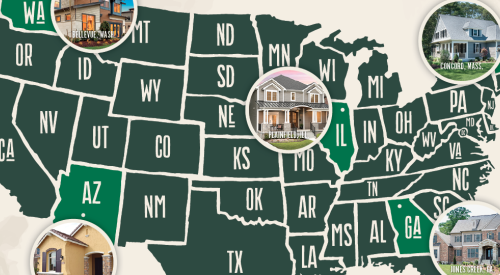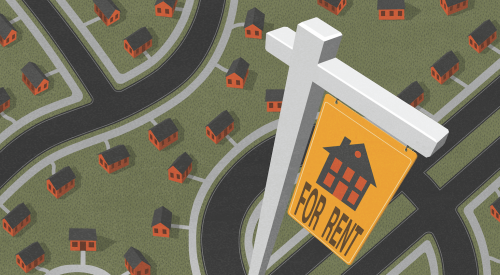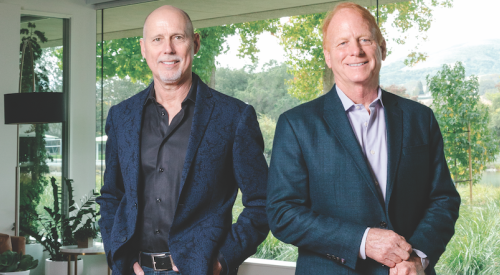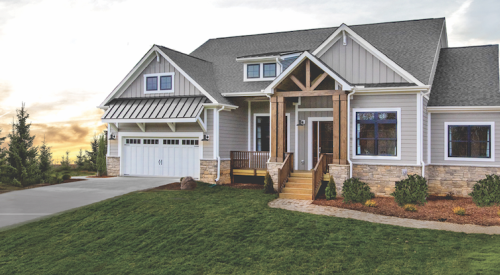The online version of this article contains additional content not included in the May/June 2021 print version.
North Carolina-based McKee Homes opened its Seaside Bay community last year, and the homes on 60 sites there have been “selling like crazy,” says president Trish Hanchette. A handful of homes are built and occupied, and build-out is slated for late 2022.
But obtaining the land for this wooded, gated neighborhood in Supply, N.C., was no stroll in the park. It involved negotiating 56 individual contracts with landowners over several years. With that, this distressed property located 40 minutes from Wilmington wasn’t a sure bet to attract buyers, even with access to a natural lake.
But in a housing market where land is expensive, lots are scarce, and even raw parcels are a competitive battleground, private builders like McKee Homes must be flexible about the land they pursue and the product they build on it. “We form our strategy around the land instead of trying to fit the land to our construction,” Hanchette says, as evidenced by the company’s diverse product mix.
New-Home Lots at a Premium
By some estimates, lots available for new-home construction declined by about 14% in 2020. “Lot shortage is the No. 1 threat to fulfilling sales commitments and growth objectives among the builders we talk with,” says Jody Kahn, SVP of research at John Burns Real Estate Consulting.
Lack of lots, like the current dearth of new-home inventory, is driving prices to new heights, with public and national builders paying top dollar (and then some) for the most-coveted finished lots in master planned communities (MPCs).
“What was selling for $15,000 to $40,000 per acre a few years ago is now selling for $90,000 to $100,000,” says Barry Bialik, founder of Compact Cottages, an Asheville, N.C.-based builder specializing in homes that average 1,500 square feet.
Compact Cottages is a prime example of how builders are making the most of the land available to them; that is, acquiring parcels that are too small or too remote for larger players in the market. The company is currently building on 2 acres in Asheville that Bialik acquired five years ago. That land had two houses on it, which were razed to make way for 45 narrow, detached and duplex housing units. As of mid-April, nine homes were completed and occupied, and another 22 are under construction. Other tracts include 1 acre that will yield five homes, 1.25 acres platted for eight to 12 homes, 2 acres for five to six homes, 1 acre for eight to 16 homes, and 1 acre with an as-yet determined density.
MORE FROM THE 2021 HOUSING GIANTS REPORT
-
Housing Giants 2021: An Unforgettable Forgettable Year: New and old challenges confronted the housing industry in 2020, and it may never be the same.
-
The Supply Chain's Perfect Storm Never before have home builders had to navigate a market where houses are pre-selling fast while the cost of so many resources is rising and so many supplies are constrained at the same time.
Beechwood Homes, which primarily builds on Long Island, N.Y., has bigger needs, but similar problems. The company looks for land that can accommodate an amenities-rich retirement community with condos, villas, and townhouses ranging in price from $500,000 to $1 million. It’s currently building on 90-acre and 72-acre parcels, and there’s also a parcel it acquired two decades ago and has since invested $60 million for infrastructure to support 2,300 units.
But, of course, Beechwood still needs a steady flow of land for the future. “I’m spending a third of my time looking for land deals, where it used to be 10%,” says company principal Steven Dubb, echoing his peers. For Beechwood, that also means finding and acquiring parcels that aren’t exactly pristine, including vacated big-box retail stores for mixed-use residential and venturing outside of its Long Island comfort zone. Last year, the builder purchased a 50-lot subdivision 220 miles north in Saratoga, N.Y., for single-family homes, and is “following its customers” moving out of New York to the Carolinas and Florida.
Home Builders Are Self-Developing Land to Survive
To satisfy their seemingly insatiable appetite for land beyond developed lots in master planned communities, public builders are increasingly receptive to giving raw land a serious look. A fourth-quarter 2020 survey of land brokers covering 72 markets, conducted by John Burns Real Estate Consulting, found that public builders accounted for 47% of raw land transactions, 8 percentage points higher than a year earlier.
In response, smaller-volume builders say they must self-develop what they buy to generate sufficient margins on land deals and as a hedge against demand fluctuations-—and to take advantage of demand by larger builders.
Riverside Homebuilders, in Fort Worth, Texas, operates a separate land development company called Lackland Holdings that develops lots for the builder’s own homes and for D.R. Horton, which acquired more than 1,300 lots last year from Lackland.
“Lot shortage is the No. 1 threat to fulfilling sales commitments and growth objectives among the builders we talk with.”
—Jody Kahn, John Burns Real Estate Consulting
Lackland’s land purchases fall into three buckets, says owner and president Tim Fleet: scattered lots in inner cities; lots in subdivisions; and 1-acre lots along the outer rim of the Dallas-Fort Worth metroplex, which account for about half of its development business. The company has 13 subdivisions currently under development and 19 to 20 more it has either closed on or has under contract. Fleet says Lackland’s minimum profit per lot is $10,000.
“We’re not waiting for people to bring property to us,” says Robert Bowman, president of Charter Homes & Neighborhoods, in Pennsylvania. The company scours data banks for land it can take through entitlement and zoning for its Great American Neighborhoods (GANs), which require 50 to 100 acres and showcase six home models. At least four new GANs are slated to open in 2021.
How Far Is ‘Farther Out’ for Land?
Bowman describes Charter Homes as a long-term land buyer that considers its production needs five years out. The builder prefers land zoned for densities of eight to 10 houses per acre, and the Great Recession taught the company to avoid land that’s too far from urban job centers.
The problem is, the definition of “farther out” keeps changing. “We’re stretching [what constitutes] metro OKC,” says Zack Roach, VP of development for Ideal Homes, based in Oklahoma City. He notes that Ideal has three developments in Stillwater, Okla., a small town 45 minutes’ drive from Ideal’s home base and Tulsa. Despite doing a ton of business there, says Roach, that market’s land has been picked over, and he thinks the area is poised to expand even farther out.
The same thing is occurring in Alabama, where developers aren’t finishing enough lots to keep pace with demand. Huntsville and Birmingham are merging into a megalopolis, despite their fringes being 30 miles apart, says Frank Plan, VP of Development of Stone Martin Builders, in Opelika, Ala.
Payne Family Homes, in St. Louis, evaluates land based on a market’s school districts, income levels, and the type of home product it wants to build there. Payne’s “wheelhouse” is land for 90 home sites; in March, it was looking at land in the suburb of Richmond Heights for a 100-townhouse development. Payne has also bought bigger properties—say, 300 home sites—as part of joint ventures with other builders.
Fischer Homes, in Erlanger, Ky. (not affiliated with Fischer & Frichtel Homes, in Chesterfield, Mo.) acquired Payne Family Homes on May 1. That deal was an exit strategy for Payne’s owners, but also should give Payne more land-buying opportunities with quicker access to capital. “There are no public builders in this market, so that’s important,” says Ken Kruse, president of Fischer Homes’ St. Louis division.

Home Builders' Land Strategies
When it Comes to Land and Lots, Bigger Builders Have Clout
Last year, Fulton Homes’ housing starts rose 62%, and the builder is on track for another big jump in 2021. Dennis Webb, VP of operations for the Tempe, Ariz., builder, says the company is in “unusually good shape” when it comes to land availability to match its sales generation.
It recently broke ground on a 550-acre master planned community called Barney Farms, at Queen Creek, Ariz., near Phoenix, where it intends to build 1,700 homes. This past February, Fulton debuted two models for the 1,000 home sites it will build on the 350-acre Escalante community, in Surprise, Ariz., a consolidation of two land deals. “We have the right amount [of land] at the right time,” Webb says.
Bigger builders like Fulton Homes, which closed 798 units in 2020, often have the financial wherewithal to thrive in hypercompetitive markets. Tri Pointe Homes’ Colorado division, for example, currently controls the lots it needs for 100% of its planned deliveries for the next two years, 40% of which are in the process of being entitled this spring, says division president Linda Purdy.
Tri Pointe prefers buying entitled finished lots in master planned communities that Purdy likens to “the food court in the mall.” The builder’s sweet spot is 100 to 150 lots per community, and in that context Tri Pointe likes to control 500 lots and manage how they come online, Purdy says.
Size doesn’t insulate bigger builders from the market’s vagaries, but it certainly gives them a leg up to ride the current wave of housing demand. “When times are like these, it’s hard to complain,” says Keith Bass, CEO of Mattamy Homes, the nation’s 20th-largest builder by home building revenue.
Last November, Mattamy acquired New Synergy Homes, in Dallas-Fort Worth, which came with the rights to 3,400 lots. In March, Mattamy paid $7.45 million for 22 acres within the 1,350-acre Gladden Farms master plan in Tucson, Ariz., for a 115-home community. The builder widened its Tucson footprint the following month by paying $5.2 million to acquire 54 acres in the fast-growing submarket of Vail, Ariz., for a 189-unit community, which should open for sale mid-2022.
MORE HOUSING GIANTS DATA: Additional 2021 Housing Giants ranking lists—home builders ranked by number of closings, housing types, and location of homes built
Bass—who describes himself as “a longer-land person”—says his company doesn’t have specific criteria for the land it purchases. “It depends on the housing segments we want to sell to in each market,” he says, and thinks that Mattamy is well-suited to grow in the current environment. “We’re well capitalized, we develop most of our land, and we’re not at the mercy of the same factors as the publics,” such as shareholder fickleness and slow decision-making.
Seeking an Equity Boost in New Metros
Historically, Trumark Homes sought land that was within an hour’s drive of major job centers, primarily infill entitled lots, especially in Northern California.
But after Daiwa House USA acquired a 60% equity stake in Trumark in January 2020, the builder has access to low-cost capital that allows it to compete for land farther out, including finished lots in master planned communities. “Our advantages include a strong track record for entitlements,” says Trumark’s co-founding principal Gregg Nelson.
Trumark wants to more than triple its closings between 2021 and 2024 to 1,300 deliveries, and the 4,000 lots it controls fall short of its four-year needs. That’s why it’s exploring new metros such as San Diego, where last summer Trumark opened a 74-acre community in Escondido, Calif., including two neighborhoods and 95 homes, for presale.
Land Development as a Profit Center
When Fischer Homes, in Erlanger, Kent. (not affiliated with Fischer & Frichtel Homes, in Chesterfield, Mo.) acquired Payne Family Homes in spring of 2021, it gained control of the seller’s 1,500 home sites across 22 communities. Fischer’s growth objectives are aggressive, and its land appetite voracious. “We’re not in desperation mode, but land is tougher to get,” says Fischer’s CEO Bob Hawksley.
He explains that the housing cycle usually dictates how much land Fischer is looking for; currently, it wants land for two to four years’ absorption. The builder also develops between 60% and 65% of the land it buys. Its development division is a profit center, “so any land purchase has to be a viable investment,” Hawksley says.
While he declined to divulge details about Fischer’s negotiating strategy, Hawksley says his company is generally “more fleet of foot” than the public or national builders, and can be "more creative" with its deal structure.
He adds that Fischer has maintained relationships with land sellers for decades. “Some are on our Christmas card list,” he quips. “At the very least, we’re in the hunt on deals we’re interested in.”
Probing the Outer Limits of Land
In a robust housing market, expansion-minded builders need to be careful not to oversell their capacities to build. “We might need to go outside our current trading area to find land,” says Fulton’s Webb. But how far out can a builder go in Phoenix, whose east side is constrained by state-owned land and Native homelands?
Fulton Homes has considered multifamily, build-to-rent, and buying finished lots in master plans. But it’s not pushing the panic button yet, and Webb remains confident his company will have enough land for future growth. “We still do what we do better than most.”
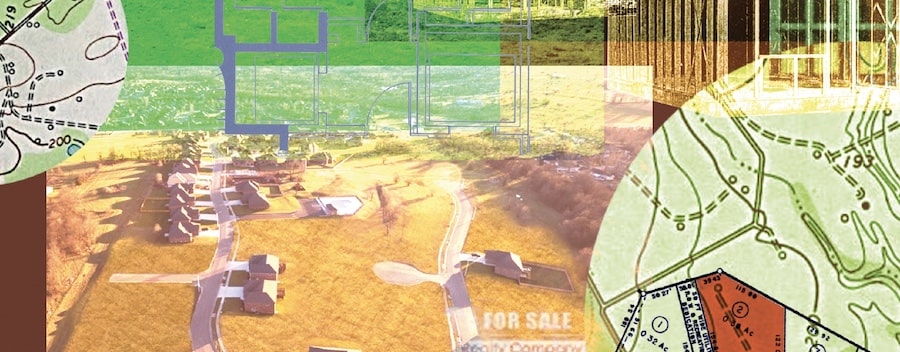
Land Acquisition's Cast of Players
Land acquisition for home building is rarely a simple process. It usually involves a host of stakeholders that can give the green, yellow, or red light to a purchase or project.
The Investor
On April 8, the investment group IHP Capital Partners, in Newport Beach, Calif., announced that its joint venture with Utah-based FieldStone Homes had acquired 113 single-family lots within the Traverse Mountain Master Plan, in Lehi, Utah. Less than a week later, IHP announced the sale of 683 home sites in its 1,275-acre community The Highlands at Tesoro del Valle, in Santa Clarita, Calif., to Lennar, the nation’s second-largest builder by 2020 revenue and closings.
Active in 18 states and controlling about 15,000 lots, IHP seeks out “finished lots at below market rate, with a winning lottery ticket attached,” quips co-president and CIO Chris Bley. But the reality is that market conditions make finding suitable land tough. “Just because something’s entitled doesn’t mean it will get built,” he says.
IHP relies mostly on its partners, such as FieldStone, to find land deals. “Land use is local, finding deals is local,” Bley says. “We partner with people who have been tracking land for many years.” IHP’s average investment ranges from $8 million to $15 million. And the big question hovering over every deal is how many housing units it translates into. “For us, velocity of construction is your friend, more so than margin,” Bley concludes.
The Developers
Newland Communities, based in San Diego, works with a network of 87 builders, 23 of which are national, to develop and build out master planned and mixed-use communities. So it’s not surprising that the company looks for land in major home building markets where it already has a presence, including Seattle, Phoenix, Denver, Austin, Atlanta, and Tampa.
But Alex McLeod, Newland’s eastern regional president, also observes more builders considering secondary markets, such as Boise, Idaho. “With the decentralization of employment, people are giving these markets a second look,” he says.
In most markets, according to McLeod, builders are bidding aggressively for lots. “Typically, builders are ahead of their scheduled takedowns,” he says, “and are seeking to buy in advance of their contractual obligations.”
On a smaller scale is Urban Community Developers (UCD) in Covington, Ky., a 501(c)(3) nonprofit organization specializing in infill development in the Cincinnati market. Former president Bill Sanderson says UCD looks for lots in low- and moderate-income neighborhoods. One recent purchase in Newport, Ky., has been undergoing considerable redevelopment after the city made lots available for $15,000; UCD transacted two purchases: one for seven lots, and another for an existing house with two lots attached. Upon completion, new homes on these lots will start in the high $200,000s.
UCD’s “cookbook” for finding scattered infill lots, according to Sanderson, starts with staying in contact with elected officials and land-use agencies that know where and when lots are available. “You need to cast a wide net,” he points out. UCD also familiarizes itself with neighborhood groups, “who know the communities better than you ever will,” he says, and is finding more adaptive reuse opportunities, especially from vacant retail.
The Seller
Sunbridge is a 24,000-acre master plan in Central Florida projected to include 36,690 single- and multifamily homes built over several decades. Tavistock Development Co. is developing this land, 19,000 acres of which came from Deseret Cattle & Citrus, part of the ranching operations of the Church of Jesus Christ of Latter-day Saints in Central Florida whose 295,000 acres are spread across three counties and constitute one of the largest cow-calf ranches in the U.S.
For years, Suburban Land Reserve (SLR), the church’s real estate firm—which acquires land through the church’s investment arm Farmland Reserve—had been cautious about selling the property for residential and commercial redevelopment and construction. “But the ranch is so large that regional impacts must be considered,” explains W. Don Whyte, VP of planning for Deseret Ranch & Citrus.
Those impacts include Osceola County’s designating 3,000 acres of ranch land for its water and waste management, and the construction of high-speed rail through its ranchland that will connect Miami to Orlando International Airport. “We have an opportunity to meet the needs of a growing region and continue to operate as a commercial cattle ranch for the foreseeable future,” Whyte says.
Looking ahead, SLR is releasing 133,000 ranch acres whose redevelopment is scheduled to begin in 2030, and envisions 182,600 residential units and 83 million square feet of commercial space by 2080.


